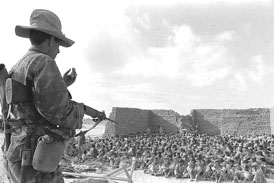Did Israeli forces massacre hundreds of Egyptian POW’s during the Six Day War? According to Israeli press reports a new documentary, “Ruah Shaked,” broadcast on Israel’s Channel 1 alleges that such a massacre did take place, and attributes the killings to the elite Shaked reconaissance unit, then led by Binyamin Ben-Eliezer, the Labor MK and retired General who heads the National Infrastructures Ministry (for details see Egypt wants probe into ‘IDF massacre’.)
The facts of the incident, in brief, are as follows. After initial stories alleging a massacre ran in 1995, the Jerusalem Post reported that “transcripts of orders from the Six Day War … clearly indicate that the alleged mass murder of Egyptian POWs near El-Arish never occurred …” Instead, what actually happened according to the Post was a full-fledged battle between armed combatants:
… several hundred armed Palestinian soldiers, in Egyptian Army uniforms, were trying to escape from the Gaza Strip towards Port Said – not knowing that the area was already under IDF control – on the last day of the war [with Egypt]. They exchanged fire with Nahal soldiers and most were later killed by soldiers from the Shaked reconnaissance unit. (August 17, 1995)
In addition, Israeli journalist Gabi Bron, who was serving with the IDF near El Arish at the time, and who is sometimes cited in reports as a witness to a massacre, has stated publicly that no massacre took place. Asked about the issue by Israeli historian Michael Oren, Bron replied:
The one hundred and fifty POWs were not shot, and there were no mass murders… In fact, we helped prisoners, gave them water, and in most cases just sent them in the direction of the Suez Canal. (New Republic, July 23, 2001)
Another supposed source for these massacre stories, according to press reports (including the Ha’aretz article cited above), is Israeli historian Aryeh Yitzhaki. But he too has denied that any such massacre took place; this is how Oren recounted their correspondence:
“In no case did Israel initiate massacres,” Yitzhaki wrote me. “On the contrary, it did everything it could to prevent them.” Yitzhaki admits that hundreds of Palestinian commandos were killed around El Arish. But that was in combat, he says, after they ambushed the IDF supply columns.
Supporting these statements by Bron and Yitzhaki is a 1967 account from the New York Times, which reported battles, but no massacres. Datelined El-Arish, June 7, 1967, the Times article reported that:
… pockets of Egyptian troops in Sinai and Palestinian troops in the Gaza Strip continued desperate resistance…
The army base here was also in Israeli hands yesterday evening after a three hour battle. Heavy casualties were inflicted, more than a thousand prisoners surrendered and some Egyptian soldiers fled into the desert.
At dawn today an Egyptian commando company struck back. An officer told reporters that the enemy had stormed the camp at daybreak with submachine guns blazing. They inflicted casualties, but were gunned down.
Later this morning, when a battalion commander went toward the home of the governor to arrange for a formal surrender, fire was opened from several houses in the town. The Israelis withdrew, and orders were given to subdue the enemy by shelling.
Brief and sporadic bursts of machinegun fire were heard between mortar blasts. Reporters were told that Egyptians were being flushed out of stone-lined trenches around the town. (New York Times, June 8, 1967; emphasis added)
Perhaps as important as the corroborating details offered by this account, is the affirmation that in El Arish on June 7th Israeli forces were accompanied by reporters who evidently neither saw nor heard even a hint of any alleged massacre.
And not just reporters; photographers also accompanied the Israeli troops throughout their advance into the Sinai. Indeed, an American photographer for Life Magazine, Paul Schutzer, was killed while riding with Israeli troops in a half-track that came under Egyptian attack. Despite the dangers, these news photographers, both Israeli and foreign, filed numerous battle images, as well as photos of the war’s immediate aftermath, such as Israeli soldiers dealing with Arab POWs in El Arish during the very time that some now charge an ongoing slaughter:
 |  | |
| June 7, 1967: Egyptian POWs being rounded up outside El Arish (Shabtai Tal) | June 7, 1967: Israeli soldier guards Egyptian POW’s at El Arish (Shabtai Tal) |
The photographers also recorded Israeli doctors tending to wounded POWs. Why the Israelis would bother to provide advanced medical care to POWs while they were at the same time slaughtering them is unclear:
 |
| June 26, 1967: Wounded POW receives care at the hospital in the Atlit POW compound in Israel. (Moshe Pridan) |
Some of the wounded Egyptian POWs bade a friendly goodbye as they were being repatriated to Egypt:
 |  | |
| July 31, 1967: After Israeli treatment wounded Egyptian POWs are carried to a Red Cross ambulance plane for the trip to Cairo. | July 31, 1967: In Red Cross ambulance plane a wounded Egyptian POW says goodbye to an Israeli. |
(For further details on these massacre allegations click here and here.)
The bottom line is that charges of Israeli wrongdoing – such as this alleged massacre – often take on a life of their own, and no matter how discredited, many are eventually resurrected and reported again, with the facts that disproved them conveniently forgotten, or at least ignored.
